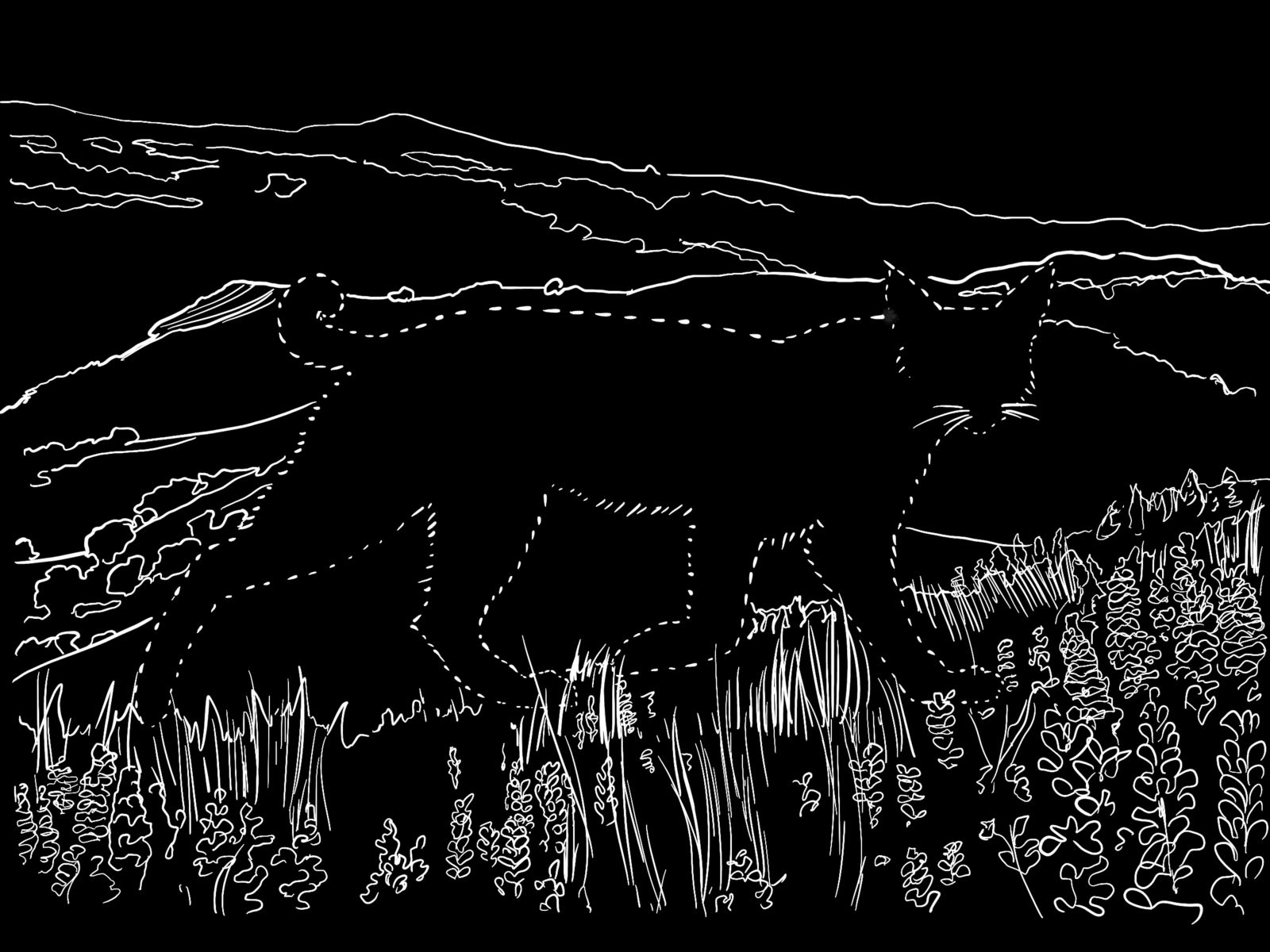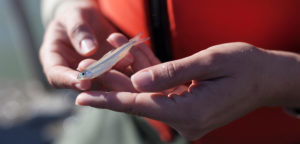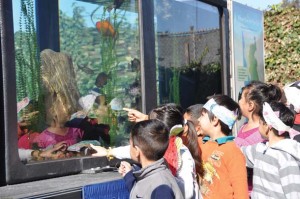We are constantly shedding DNA.
Skin cells smeared on the handle of a mug, fallen hairs, and various body fluids cast our unique genetic code into our environment. Everyone else sheds too––from trees and birds all the way down to microbes. Bits of DNA linger on the forest floor, in sewage, in the ocean, and even in the air. While usually invisible, these ubiquitous strands of genetic evidence have stories to tell, especially when researchers scoop them up into a tube and take them back to the lab.
Scientists call these lingering strands “environmental DNA,” or “eDNA,” and the technology to analyze them is making its way into ecology.
“They’re collecting bees’ DNA from flower pollen. They’re collecting eDNA of lynx and bobcats from a track in the snow,” says James Birch, a researcher at MBARI, the Monterey Bay Aquarium Research Institute, who is developing an underwater eDNA-sampling robot. “[Environmental] DNA is allowing us to see the natural world, even when the organisms that make up that world are not in our visual field.”
To find out which creatures have roamed a place, researchers match eDNA fragments to a library of known genomes. The technique has its limitations. But because it is much cheaper and faster than traditional field observations and surveys, eDNA analysis is emerging as a potentially powerful tool to assist conservation and stewardship—by detecting invasive and endangered species, monitoring biodiversity, and tracking how ecosystems change over time.
“I see [eDNA] being instrumental in helping us hone our management questions and get the best information back,” says Daphne Gille, environmental program manager at the California Department of Water Resources. “It’s a cost-effective and highly sensitive way to get some information that we can’t get with other methods.”
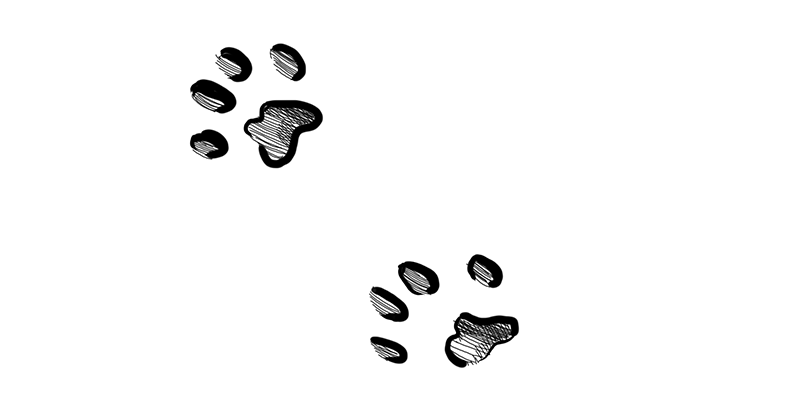
A technique in its infancy
Amazing as it is, there’s plenty eDNA sequencing can’t tell you. It doesn’t reveal how many mountain lions passed by this year, or show the number of saplings versus adult trees in a park, or how long ago a creature passed through. And identifying species with eDNA is only possible if that species has already been sequenced and added to a reference library––but many creatures have yet to be sequenced at all, and simply appear in results as “unknown.”
“We have these huge lists of species,” says Rachel Meyer, professor at UC Santa Cruz and director of CALeDNA, a research network that samples and analyzes eDNA from habitats throughout California. “A lot of them are things we just don’t know anything about, like archaea, a lot of protists. There’s barely a Wikipedia page for a lot of these things.”
To fill these gaps in the genetic library, labs across California are sequencing and assembling the most comprehensive genetic encyclopedia of creatures yet under a state-funded initiative called the California Conservation Genomics Project.
Some land managers and agencies have been skeptical of eDNA sequencing’s effectiveness and relevance to their work, says Gille, the DWR manager. “When I was first working for management agencies, all I heard was, ‘eDNA doesn’t work,’” she says.
Gille believes that view was often based on a misunderstanding of the meaning of positive and negative eDNA detections. A positive detection means an organism was at or near the sampling site at some point. A negative detection, however, doesn’t prove that the species isn’t there––though, as Gille points out, that’s also true of other sampling methods.
“No method is perfect, but eDNA can tell you a lot,” says Gille.
Despite these limitations, many California agencies and resource managers are making use of eDNA sequencing in pilot projects. CALeDNA’s partners include California State Parks and the National Park Service.
“The technology is in its early days as a tool for land managers,” says Eric Wrubel, a biologist and San Mateo land manager for the National Park Service’s Golden Gate National Recreation Area. Wrubel partnered with CALeDNA to identify the pollinators of endangered wildflowers. “I’m just learning about this technology, and I think it’s going to take a while to figure out how to use it best.”
How eDNA analysis works
There are two main ways to sequence eDNA samples. For both methods, samples are sent to a sequencing lab, which can mean weeks or months before results are complete.
The first method is PCR testing—the same technology used to detect coronavirus genes from a nose swab. It amplifies small bits of DNA, and is used when one is looking for a specific creature, often an endangered or invasive species. This technique requires that the target creature has a genome that’s been sequenced and uploaded into a genome library.
For example, CALeDNA partnered with National Park Service researchers in Tomales Bay to look for tidewater gobies, an endangered intertidal fish. They sampled tidepools and Tomales Bay, and looked for telltale DNA chunks unique to the tidewater goby’s genome. They found signs that the fish was still there.
The second common eDNA sequencing technique is known as metabarcoding, and it’s used to survey biodiversity. Every strand of DNA in the sample is sequenced. Then, researchers compare those fragments against reference DNA in a genome library to find the species that most closely match. This way, researchers can sequence everything in an eDNA sample to get a list of all the species found in it––and, likely, many unknown fragments with no matches. A single sample in CALeDNA’s database may contain DNA from hundreds of different organisms; some contain DNA from over 1,500.

Finding the unseen
With eDNA sequencing, researchers can find traces of species that traditional surveys might miss—creatures that are nocturnal, scarce, or simply too small to see.
“I’m very interested in the small, because they drive the whole system,” says Jen Quick-Cleveland, a CALeDNA researcher at UC Santa Cruz.
Quick-Cleveland is studying how soil microbe communities change before and after wildfires. Her team of UC Santa Cruz students sampled soil from burned and unburned forests across California, and are waiting to see which of their sites burn next to sample them again. “Comparing how the soil community changes over those conditions will tell us a lot about how ecosystems respond to wildfire,” says Quick-Cleveland.
Quick-Cleveland is also using eDNA surveys to track the microscopic algae that drive harmful algal blooms. For years, Pinto Lake in Santa Cruz County was ravaged by severe algal blooms that made it one of the most toxic lakes in California. In 2017, the city of Watsonville treated the lake with chemicals, and Quick-Cleveland is now using eDNA to compare Pinto Lake’s microbes with a nearby lake that was never treated. She hopes to use eDNA data to weave together a bigger picture of how algal blooms develop and impact their ecosystem.
“Land managers plus [eDNA] would be such a killer combination,” Quick-Cleveland says. “This is about [getting] a broad picture of how the entire ecosystem changes. Marrying that with observational data and their experience is a powerful management tool.”

Finding invasives, before they take over
Traces of eDNA can reveal the presence of an invasive species before it becomes visible or wreaks havoc on an ecosystem. Since 2016, the US Geological Survey (USGS) has been developing national eDNA programs to monitor lakes, streams, and rivers for invasive species such as zebra mussels and invasive carp.
“The sooner you find out about it, the more likely you are to control or minimize the impact of that invader,” says Adam Sepulveda, a USGS biologist. Sepulveda works on eDNA sampling robots that look for invasive species in watersheds across the country.
These eDNA monitoring systems can give managers an early warning on invaders, and help them decide where to focus interventions.

Finding endangered species, before they’re gone
The same eDNA monitoring technology can be used to detect the survival and movement of endangered species.
Once ubiquitous in the San Francisco Bay estuary, Delta smelt numbers have plummeted since the 1990s. Now there are so few that managers struggle to catch any in their native Sacramento-San Joaquin Delta. In a desperate attempt to bolster the population, managers have recently started releasing hatchery-raised smelt.
In March 2023, the California Department of Water Resources, in partnership with MBARI, installed an autonomous eDNA sampler near export pumps at Clifton Court Forebay, a reservoir in the Delta, to look for larval smelt.
“It’s important to use eDNA not only to track what’s left of the wild population, but also to track our [hatchery] release efforts,” says Gille. “We have a lot of questions about Delta smelt after they’re released––what would be the best place for them to go, and best place for us to release them? eDNA can help us with that.”
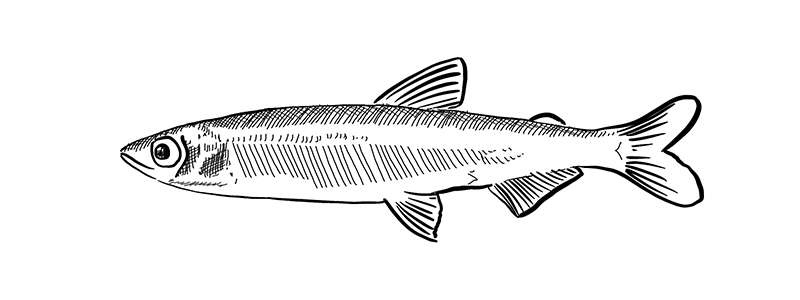
CSI: Vernal Pools
Endangered fairy shrimp, California tiger salamanders, and whimsical rings of wildflowers can all be found at the shallow, ephemeral vernal pools that dot California’s grasslands. Many of the species found here are unpredictable and cryptic. So to survey vernal pool biodiversity at the pools in UC Merced’s 6,500-acre grassland reserve, researchers used metabarcoding.
“Every year is different,” says Jason Sexton, an environmental biology professor at UC Merced. “You get different plants coming up in different years because of the rainfall variation. So it’s a perfect testing ground for these [eDNA] tools.”
In 2017 and 2018, dozens of community scientists came out to the UC Merced reserve to help sample water and soil from five vernal pools. “One of the greatest rewards was those sampling days with the community scientists,” says Dannise Ruiz, who worked on the study as a postdoc in Sexton’s lab. She now works at USGS, using eDNA to detect invasive species. “You wouldn’t think taking little vials and filling them with dirt would be like a party, but it just always had a party feel.”
The team was amazed by the sheer diversity the survey found in what looks like empty grassland. Field observations confirmed 22 native plant species found with eDNA sequencing. One water sample even detected an endangered plant, Colusa grass (Neostapfia colusana), before it emerged and became visible later in the season.
“In some ways, this feels like CSI: Vernal Pools,” says Sexton. “Who was here? And what was their role? And what did they do?”

Looking ahead
As eDNA sequencing becomes more widespread in ecology and conservation, some researchers are looking into what eDNA could tell us about an ecosystem’s future. Levi Simons, a postdoctoral researcher with CALeDNA at UCLA, is building a platform called eDNA Explorer, which he likens to an “iNaturalist for genetics.”
The platform would allow researchers to upload their sequencing results and share them publicly. Simons envisions a future where eDNA datasets are so thorough that they can be used to make statistical predictions—like weather forecasts—about what will happen to an ecosystem. “When you integrate this community science framework with this big data science, it can get really powerful,” says Simons.
For now, state and local managers are just beginning to integrate eDNA sequencing into conservation and biodiversity projects. “We need to make the next leap and really implement [eDNA] in our programs,” says Gille. “It’s something that I see as a critical part of the management of our ecosystems.”


